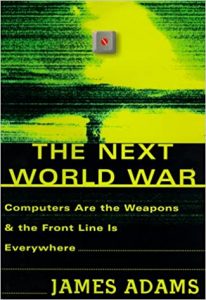
The constant characteristic of the information environment has been one of cataclysmic change, driven by a seismic shift from the wired to the wireless worlds. James Adam’s effort to highlight how future battlefields will be dominated by bytes, not bullets, is reflected in his work, ‘The Next World War’. The primary focus of the book has been to freeze the debate that has been raging since the end of the Cold War. [1] A world defined less by the equalizing influence of the constantly looming fear of Mutually Assured Destruction (MAD)[2], and more by the war in the ‘infosphere’. (Adam, 1998) According to Catherine A. Theohary, Information Warfare is defined as an activity undertaken by government groups or individuals to gain electronic access to information systems in other countries as well as activities undertaken to protect their information infrastructure. To embrace the work of the intelligence communities, the government, and those serving on the front lines, the author has adopted the broader definition of ‘information, and ‘warfare’. James Adam, in his conception of information warfare, has broken the term into three parts. The first is Perception Management, where information is the message. The second is Systems Destruction, where information is the medium. Lastly, Information Exploitation, where the information is a resource for the opponent to exploit. (Adam, 1998)
James Adam takes the reader on a comprehensive and illuminating tour of micro-electro-mechanical systems, non-lethal weapons, and instantaneous communications. The author takes the example of US peacekeeping missions in other countries. The first amongst these is the Gulf War where the first noted use of the techniques of information warfare that began with Operation Desert[3] Storm was implemented when control of the electronic spectrum created an insurmountable imbalance between the combatants. Moving on, the author takes the example of Somalia- a watershed moment in American foreign policy, Haiti and Bosnia. (Adam, 1998) These cases demonstrate the power of information not merely as a force multiplier but as a paradigm shifter. At the onset, I strive to shed light on the distinct features of the book and the important topics that it covers. Moving on, I focus on the drawbacks of the book.
The burgeoning use of information warfare questions the applicability and influence of theories of warfare propounded by intellectual heavyweights such as Sun Tzu and Carl von Clausewitz. Clausewitz has been an iconic figure in the United States military. While Clausewitz’s core belief that ‘war is politics by other means’ has stood the test of time, his theory seems outdated and redundant. Martin Van Creveld, a military scholar at the Hebrew University in Jerusalem, believed that from the end of the Second World War, Clausewitz became all the more irrelevant because his theory was centred around the ‘Wonderful Trinity’ of government, military, and people. Clausewitz’s traditional view held relevance until 1945 when fighting that engulfed Europe saw nations face each other on battlefields.[4]
Since the expanding use of information warfare, there has been an increasing focus on the writings of Sun Tzu from 500 BC. While Sun Tzu doesn’t exactly point to information warfare, he does lay out a framework that underscores the importance of information and knowledge. Sun Tzu writes, ‘Know the enemy and know yourself.[5] Sun Tzu’s use of words like, ‘know’ and ‘ignorant’ correlate neatly with concepts such as information, knowledge, and understanding. Sun Tzu’s work led to the realization that data could be converted into information, and that information could form the basis of a strategy and knowledge. Ultimately, this knowledge could be the building blocks of a predictive understanding of the battle. ( Adam, 1998)
Moving away from the ideology that defines warfare, the author goes on to shine a light on the technological advances and changes that have taken place. James Adam calls attention to two specific aspects that emanate from the information revolution. The first is the ability to make decisions faster and more efficiently while at the same time destroying the enemy’s ability to make decisions. ( Adam, 1998). The second is to move the soldier further away from the point of contact with the enemy while making the firepower that the soldier can deliver much more intense and accurate. In light of these underlying principles, the United States military has taken a substantial leap forward. While it may seem fictitious to think of re-engineered 707’s, militarised ants, and camouflage suits made of exoskeletons, the reality is however not too different. Drawing on the use of the ‘Land Warrior’, and the ‘Applique’, the author demonstrates how far the United States has come from the Cold War days and how instrumental have these technologies been in altering the face of warfare, based on the key principles highlighted above. But the question still stands amidst the rubble and dust of war, is it truly bytes and not bullets that pack the greatest punch? There is no denying that taking electronics out of information and warfare reverts to the days of runners, signal flags, and scraps of paper. ( Adam, 1998) However, despite the significant strides that have been made in this area, there persist several shortcomings. The United States Military for the first time tested Land Warrior and Applique in the field in March 1997 during an Advanced Warfighting Exercise at the Army’s National Training Center, Fort Irwin, California.
Having reflected on Soviet information machinery, James Adam in his conclusion shines a light on what information warfare means to the West. The end of the Cold War has strategically altered the playing field. Moreover, the disintegration of the Soviet block has left NATO struggling to find an identity. The author compares America post the cold war to the French Republic in 1871. Comparisons of the two military giants throw up lessons that can be learned. Across the world, ancient ethnic tensions that once were held in check by the overarching geopolitical imperative of the superpower rivalry are now causing conflicts in countries as diverse as Somalia and Bosnia. From a global perspective, the author notes that as a result of the information revolution, the fragile control that nations have over their people have begun to disintegrate as the concepts of country, loyalty, and national identity have eroded in the face of a promise of a different world where no such convenient restraints exist. ‘Dulce et decorum est pro portia mori’, is no longer the dictum governing a soldier’s behavior. This can partially be attributed to the lack of leadership ( Adam, 1998) Through these distinct and precise points, James Adam has been successful in highlighting how the military establishment is falling behind the information curve.
There is no doubt that the author has scripted a masterpiece. However, as a reader, I felt that there were a few aspects that have been ignored and would have amplified the value of the book. The author has focused on military developments that have altered the face of battle but has failed to show how technology acting as a force multiplier has fuelled and driven this change. The increasing importance of information runs parallel to advances in technology. Martin van Creveld believes that war is completely permeated by technology and governed by it. [6]Considering that computers are becoming more commonplace and that they are increasingly tied together via networks, it is important to consider how this affects the conduct of war and inter-state engagement.
Traditional warfare has been defined through the principle of ‘pacta sunt servanda’ of conventional international law and the consistent practice of customary international law. (Greenberg et al., 1998) However, as information warfare has taken war out of the physical, kinetic realms and brought it into an intangible, electronic one, it has become difficult to define, restrict and control the use of informational warfare through practices of international law. Three primary ways are burgeoning use of information warfare challenges in international law. The first amongst these is the intangible damage that such attacks cause may be different from the physical damage caused by traditional warfare. (Greenberg et al., 1998) Secondly, the ability of signals to travel across international networks or through the atmosphere challenges the concept of national and territorial sovereignty. Lastly, it is difficult to define targets of information warfare as military or civilian. (Greenberg et al., 1998)
In light of these points, the question remains how one can restrict and more importantly define the activities under the broad ambit of information warfare. A multilateral treaty is the most viable option. However, even with this, the problem remains of determining what international legal principles concerning informational warfare are likely to best serve long-term national interests. James Adam through his work has established that advances in information and communications technology have had unprecedented consequences on the very nature of warfare. War has been distinctly revolutionary owing to several factors brought about by the increasing use of information warfare. James Adam’s work has acted as a suitable reflection on information warfare as perceived by government and society. Citizens are shaping their ability to use information, for good and evil. Creating essentially an ‘electronic democracy’. James Adam has also importantly highlighted that information warfare is as much about attitude as about ammunition, as weapons were only a part of the picture. Rushing headlong into a gleaming technology-driven future without any guiding philosophy of leadership renders the giant vulnerable. (Tenet, 2004)
Endnotes:
Adam , J. (1998). Introduction . In The Next World War: Computers Are the Weapons & the Front Line is Everywhere. (Vol. 1, pp. 13–18 ). essay, Simon and Schuster, Inc. .
Adam , J. (1998). War in the Infosphere . In The Next World War: Computers Are the Weapons & the Front Line is Everywhere. (Vol. 1, pp. 22–34). essay, Simon and Schuster, Inc. .
Adam , J. (1998). March of the Revolutionaries . In The Next World War: Computers Are the Weapons & the Front Line is Everywhere. (Vol. 1, pp. 93–101). essay, Simon and Schuster, Inc. .
Adam , J. (1998). From Double Tap to Double Click. In The Next World War: Computers Are the Weapons & the Front Line is Everywhere. (Vol. 1, pp. 105–121). essay, Simon and Schuster, Inc. .
Adam , J. (1998). The New Arms Race. In The Next World War: Computers Are the Weapons & the Front Line is Everywhere. (Vol. 1, pp. 233–244). essay, Simon and Schuster, Inc. .
Adam , J. (1998). Conclusion. In The Next World War: Computers Are the Weapons & the Front Line is Everywhere. (Vol. 1, pp. 305–313). essay, Simon and Schuster, Inc. .
Tenet, G. (2004). Global Information Assurance Certification Paper. GIAC Certifications. https://www.giac.org/paper/gsec/3873/information-warfare-cyber-warfare-future-warfare/106165.
Greenberg, L. T., Goodman, S. E., & Soo Hoo, K. J. (1998). Information Warfare and International Law. http://www.dodccrp.org/files/Greenberg_Law.pdf. http://www.dodccrp.org/files/Greenberg_Law.pdf.
Joyner, C. C., & Lotrionte, C. (2001). Information Warfare as International Coercion: Elements of a Legal Framework. . European Journal of International Law , 12(5), 825–865.
[1] Adam , J. (1998). Introduction . In The Next World War: Computers Are the Weapons & the Front Line is Everywhere. (Vol. 1, pp. 13–18 ). essay, Simon and Schuster, Inc
[2] Principle of deterrence founded on the notion that a nuclear attack by one superpower would be met with an overwhelming nuclear counterattack such that both the attacker and the defender would be annihilated.
[3] The Gulf War was a war waged by coalition forces from 35 nations led by the United States against Iraq in response to Iraq’s invasion and annexation of Kuwait arising from oil pricing and production disputes.
[4] Creveld, M. van. (1990). Technology and War, Martin Van Creveld. 1988. Free Press (The Macmillan Co.), New York. 304 pages. ISBN: 0-02-933151-X. $22.95. Bulletin of Science, Technology & Society, 10(1), 47–48. https://doi.org/10.1177/027046769001000139
[5] Tipton, H. F., & Krause, M. (2007). Information Security Management Handbook, Sixth Edition (6th ed.). CRC Press.
[6] van Creveld, M. (1991). The Clausewitzian Universe and the Law of War. Journal of Contemporary History, 26(3), 403–429. https://doi.org/10.1177/002200949102600304













